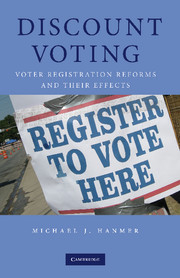Book contents
- Frontmatter
- Contents
- Acknowledgments
- Introduction
- 1 Motivation and a New Theoretical Framework
- 2 The Purposeful Adoption of Election Day Registration
- 3 Election Day Registration by Choice and by Federal Mandate
- 4 Motor Voter by Choice and by Federal Mandate
- 5 Registration and Voting in the Post-NVRA Era
- 6 Election Reform and the Composition of the Electorate
- 7 EDR on the Ground and Prospects for the Future
- APPENDICES
- References
- Index
4 - Motor Voter by Choice and by Federal Mandate
Published online by Cambridge University Press: 02 December 2009
- Frontmatter
- Contents
- Acknowledgments
- Introduction
- 1 Motivation and a New Theoretical Framework
- 2 The Purposeful Adoption of Election Day Registration
- 3 Election Day Registration by Choice and by Federal Mandate
- 4 Motor Voter by Choice and by Federal Mandate
- 5 Registration and Voting in the Post-NVRA Era
- 6 Election Reform and the Composition of the Electorate
- 7 EDR on the Ground and Prospects for the Future
- APPENDICES
- References
- Index
Summary
In Chapter 3, I demonstrated that the effect of election day registration (EDR) differs across social and political contexts. In the already high turnout states of Minnesota and Wisconsin, EDR led to a small but significant increase in turnout. The effect of EDR in Idaho, New Hampshire, and Wyoming, states that adopted EDR to avoid federal motor voter legislation, fell short of expectations based on previous studies and the mark set by Minnesota and Wisconsin. These conclusions were derived primarily by using the difference in difference method, a method that aims to control for endogeneity by comparing turnout over time in comparable states. The purpose of this chapter is to estimate the effect of motor voter as implemented via state law and via the National Voter Registration Act of 1993 (NVRA). The states with pre-NVRA laws that were deemed suitable for analysis are Michigan, Minnesota, Nevada, and North Carolina.
As discussed in Chapter 1, although some scholars have treated EDR and motor voter as substitutes (Teixeira 1992; Highton and Wolfinger 1998), the policies must be investigated separately. EDR and motor voter policies differ mainly in terms of the costs imposed on voters, but also in terms of the likelihood that interest in voting drives the decision to register, and the ease with which political parties and candidates can contact registrants, all of which lead to differential expectations with respect to the respective policy's effect on turnout.
- Type
- Chapter
- Information
- Discount VotingVoter Registration Reforms and their Effects, pp. 106 - 125Publisher: Cambridge University PressPrint publication year: 2009

